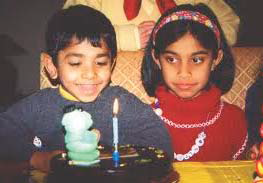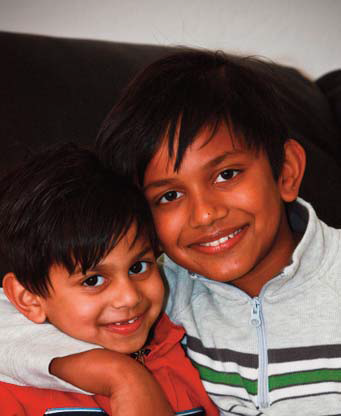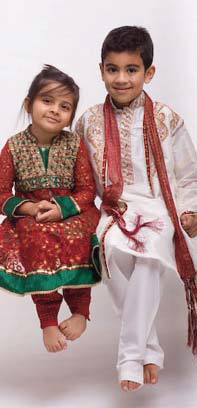Teaching Good Manners Age by Age
By Sara Sullivan
It’s never too early for your kids to learn how to behave politely. Here, a top manners expert offers a step-by-step. One of my favorite stories about the importance of good manners came from my great-grandmother-in-law, Emily Post. A friend of hers took a trip to England and unexpectedly wound up meeting Queen Elizabeth. When the friend returned, everyone wanted to know how she had handled this challenging experience. "It was very simple," she replied. "I used the only set of manners I have." To me, this story illustrates the best reason to begin teaching manners to children when they are young. Given enough time and practice, good manners become an automatic response. And polite kids grow into adults who treat others respectfully and know how to face any situation with grace and confidence.
But teaching courteousness to children can be a daunting task. Many parents are uncertain about when young kids are capable of learning certain behaviors, or they simply get frustrated with issuing constant reminders. This age-by-age guide – and some patience on your part – will help you figure out when, how, and what to teach your child about manners as he grows. Here’s how to ut your children on the road to polite behavior and social success.

6 months to 1 year – Introduction to Manners
Babies are, of course, too young to learn manners However, it’s important to remember that even very young children are able to copy their parents’ behavior. Babies as young as 6 months begin to mimic adult actions and facial expressions. By age 1, when they’re in unfamiliar situations and environments, they’ll search their parents’ faces to find out what the appropriate reaction is. That’s why acting in a courteous, considerate manner yourself – saying please and thank you and speaking to your baby in a pleasant voice – will lay the foundation for teaching your child manners in the future.
1 to 2 years – The Basics
 Teaching manners to a toddler who’s mastering so many other new skills can seem like an exercise in futility. During their second year, however, children begin to blossom into social creatures, and they need to be taught the fundamentals of polite behavior. Be patient, toddlers are notoriously short on memory, attention span and empathy, so you’ll be repeating yourself a lot. And remember that toddlers are far more cooperative when they’re not crabby. A child who’s skipped his afternoon snack and is low on sleep will be less likely to show off his social skills than one who’s satisfied and wellrested.
Teaching manners to a toddler who’s mastering so many other new skills can seem like an exercise in futility. During their second year, however, children begin to blossom into social creatures, and they need to be taught the fundamentals of polite behavior. Be patient, toddlers are notoriously short on memory, attention span and empathy, so you’ll be repeating yourself a lot. And remember that toddlers are far more cooperative when they’re not crabby. A child who’s skipped his afternoon snack and is low on sleep will be less likely to show off his social skills than one who’s satisfied and wellrested.
SAY PLEASE: Around age 1, your child will begin to acquire language at breakneck speed, so make sure that please and thank you become part of his growing vocabulary. Remind him to say these magic words whenever he wants a snack or a toy.
HI SOCIETY: Greeting people and saying good-bye are other basic social skills that toddlers pick up easily. Most 1- and 2-year-olds love saying hello and good-bye when prompted.
SHARE AND SHARE ALIKE: Toddlers are just beginning to understand concepts such as sharing and taking turns, so they’ll need your guidance. The best way to teach a toddler how to share is to give her two similar toys and help her hand one of them to her playmate. That way, she’ll start to learn about sharing without having to give anything up. In a situation in which there’s only one toy and a tug-of-war occurs, say "It’s Billy’s turn now. When he’s finished, you can play with the truck. Now let’s play with another toy."
TABLE TALK: Toddlerhood is not the time to teach table manners in earnest. At 2, many children are hardly even interested in sitting down to eat. However, you can start laying the groundwork now. If your child is still in a high chair, pull it up to the table so he gets used to the concept of a family meal. Many toddlers like to experiment with big-kid concepts such as using a spoon or a fork, so provide some kidfriendly utensils for your toddler to try.
3 to 5 years – Making the Social Scene

At about age 3, children start to put their fledgling social skills to the test. They attend parties, go to preschool, and visit friends and relatives. These social milestones provide parents with a variety of opportunities to teach kids etiquette skills. And because the essence of good manners is consideration of others, your child’s growing sense of empathy should make your lessons stick more easily.

PATIENCE PRIMER: Learning how to wait patiently will help your child cope with new situation such as standing in line for a snack at preschool or waiting for another child to finish his turn on the swing. Remember, though, it’s very difficult for a young child to hold on to his thoughts – or hold off on his actions – until his turn comes.
Your own dinner table is a good place to teach patience. When you’re serving dessert, for example, you could say, "I can carry only two dishes at once. After your father and sister get theirs, I’ll bring yours over." And when your child interrupts you in conversation, gently remind him that someone else is talking and he’ll have to wait until you’re finished.

Don’t forgt to let your child know that in some circumstances its okay to interrupt people when they’re talking. Say, "If you really need to use the bathroom or if someone is sick or needs help, you should let me know. Just say, ‘Excuse me.’"
I’M SORRY: Learning how to offer an apology is a key skill for children this age. Explain to your child that when she does something – whether purposely or accidentally – that hurts another person or damages property, it’s important to let that person know she’s sorry. You could explain this concept to your child by saying something like "Remember how sad you felt when Michael accidentally knocked over your block tower? Saying, ‘I’m sorry’ makes people feel better."

GREETINGS: By now, your child is able to address adults as Mr., Mrs., Ms., or with first names when appropriate. Games such as tea party and doctor’s office are great ways to help your preschooler learn how to greet people appropriately. When you meet a friend prompt your child to greet him: "Say hi to Mr. Smith, Ben." Remind children that greeting people warmly, calling them by name, and making eye contact makes them feel good.
TABLE TACTICS: Table manners are often a major concern for parents of preschoolers and kindergartners. Use this time to focus on a few important general guidelines rather than overwhelm your child with information and a list of dos and don’ts.
First and foremost, teach him to sit nicely in his chair without slouching or sitting sideways. Getting your child a comfortable, kid-friendly chair definitely helps. Provide utensils designed for small hands, place food within your child’s reach, and include him in the conversation. If he feels that he’s genuinely participating in the meal, he’s more likely to rise to the occasion and act like a big boy at the table. Children should also learn that meal-time is not for blowing milk bubbles or making mashed-potato mountains. Teach him to eat neatly and place his napkin in his lap. You might say, "Talking while you’re eating or making noises with food disturbs other people. When you eat, try to be neat." (Exploring different food tastes and textures is fun and educational for kids this age, though, so set aside another meal or snack when your child can be allowed to do so.)
Finally, teach your child how to refuse foods politely. Offer him a food you know he dislikes, and prompt him to say, "No, thank you." Then explain to him that calling food yucky or making a face is not nice behavior. On the flip side, remind kids to compliment the cook when they like what she has served.
And because many young kids can’t sit still for the duration of a long meal, it’s okay to let them leave. Just remind your child to ask if he may be excused before he leaves the table.
MAKE A NOTE OF IT: Receiving presents is so exciting that kids may forget to say thanks. If your child opens a gift in front of the person who gave it, prompt him to offer his thanks. If someone sends your child a present, help him compose a thank-you note. Preschoolers are too young to write, but involve your child in the process: Ask for his input, write the note for him and have him sign his name.
6 years and beyond – The Finishing Touch
 By this age, your child spends most of his days using his social skills – at school, on playdates, and at soccer practice. He’s comfortable with sophisticated social tasks such as hosting his friends, using the phone, and being a considerate guest. Fortunately, most children this age love to please their parents, so you’ll probably get lots of cooperation.
By this age, your child spends most of his days using his social skills – at school, on playdates, and at soccer practice. He’s comfortable with sophisticated social tasks such as hosting his friends, using the phone, and being a considerate guest. Fortunately, most children this age love to please their parents, so you’ll probably get lots of cooperation.
LET ME ENTERTAIN YOU: To teach your child to be a good host, prompt her to tell you what she likes about playing at a friend’s house. For example, does she like when her friend lets her play with the best Barbie or offers her a drink? Then remind her the same sort of consideration when she has a friend over at her house.
Before your child goes to another home on a playdate, remind him to be a good guest and make sure he’s clear on what that means. You could say, “When you go to Jeremy’s, remember to follow his parents’ rules, and thank him and his family for having you over.”
PHONE MANNERS: Teaching phone skills is usually an easy task, because most children are eager to use this grown-up toy. Tell your child to say, “Hello?” when she answers the phone. If the cal isn’t for her, prompt her to ask “Who’s calling, please?” If your child wants to call a friend, read out the number to her while she dials it. Remind her to introduce herself first: “Hello, this is Susan. May I speak to Janey, please?”
WELL-NOTED: Kids this age should be able to write their own thank-you notes. Something short and simple is fine. For example, your child might write, “Dear Aunt Sue, thank you very much for the baseball cap. I hope to see you soon. Love, David.”
Though your children will be on their own more often now, the good manners you have instilled will always stay with them. After years of reminders, your reward will be a courteous, charming, and well-manners child.

 1.408.254.0954
1.408.254.0954




